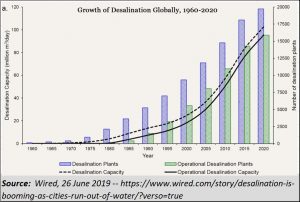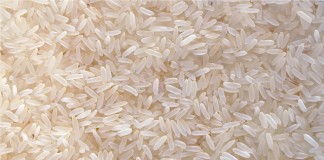https://www.freepressjournal.in/analysis/niti-aayog-is-wrong-about-water-desalination
Niti Aayog is wrong to recommend water desalination
RN Bhaskar – August 8, 2019
Last fortnight, Niti Aayog, the national official think-tank, came up with a proposal that — in order to address the country’s water woes — desalination plants should be set up along India’s vast coastline. It also sent the proposal to the Ministry for water (Jal Shakti) for further advice and action.
The proposal is absurd. It is unwise, even harmful for India.
 Yes, global demand for desalination plants has been growing (see chart). But more than 50% of the plants have been set up in the Middle East where there is just no, or very little, rainfall. About a quarter of desal capacity has been set up by rich countries. Another quarter of the capacity has been in countries where money is known to be the big influencing factor for clinching the orders. For India, therefore, the desalination proposal is unwise.
Yes, global demand for desalination plants has been growing (see chart). But more than 50% of the plants have been set up in the Middle East where there is just no, or very little, rainfall. About a quarter of desal capacity has been set up by rich countries. Another quarter of the capacity has been in countries where money is known to be the big influencing factor for clinching the orders. For India, therefore, the desalination proposal is unwise.
But why is desalination a bad idea for India? There are several reasons.
First, desalination would make India temporarily forget to look at the more serious – and relevant — issue of water management and waste management (http://www.asiaconverge.com/2019/07/water-and-waste-management-key-to-pm-plans/). They are burning issues, which if handled properly could ensure that India has enough water.
Second, as mentioned earlier, India has more fresh water as part of its land mass than most Asian countries (http://www.asiaconverge.com/2019/05/india-should-learn-water-management-from-china/). Even the Central Water Commission admits that India is water stressed, not water scarce (http://www.asiaconverge.com/2019/07/india-faces-no-scarcity-of-water/).
The trouble is that India wastes water. It does not have in place systems to measure the water consumed by farmers and individual families. Even in places like Mumbai, where households had separate meters, the municipality has opted for having one common meter for buildings. Without knowing how much water is consumed by which family, and by which farmer for which crop, no water management system can be set up. Only such an exercise would allow policymakers to arrive at a pricing policy for water – used by industry, offices, agriculture and common households.
Third, India allows water theft (http://www.asiaconverge.com/2019/06/the-stranglehold-of-the-water-tanker-mafia/), either by tankers, or by agro-based industries. Desalination will not stop this.
Fourth, India does not penalise water pollution and the failure to ensure zero discharge (http://www.asiaconverge.com/2019/07/the-govt-fails-in-water-harvesting-and-waste-management/). What is the use for water harvesting, if India allows that water to get contaminated either by effluents pouring into the water, or by people bathing or defecating near such water reservoirs? Similarly, does it make sense to spend money cleaning the Ganges day after day without first stopping effluent discharge into the river? It is time the government made water pollution an act of sabotage against national interests in much the same way it would if someone actually poisoned a village water well.
Finally, desalination causes tremendous environment damage (https://www.wired.com/story/desalination-is-booming-as-cities-run-out-of-water/?verso=true). This is because for every two litres of sea water, only one litre of drinkable water gets produced. The residual water – known as brine — has high levels of salt which destroys sea life. Even if this were to be diluted, the pumps sucking in almost 100 million litres of water each day will kill fish, sea creatures and eggs which get stuck to the mesh at the suction inlet. That will hurt fishing and seaweed harvesting interests very badly (http://www.asiaconverge.com/2018/06/harvesting-seaweed/). That also explains why countries that have set up desalination plants are not fish exporters. India exports around $7 billion of fish each year. Fisherfolk also sell fish to the domestic market. Desalination could destroy all this.
There is one more issue that people often forget. Unless there are strict norms for monitoring capital and operating costs — and strict quality assessments — desalination could bleed the country financially and push up its balance of payments. Consider how almost all desalination plants have been built at costs which are twice (or more than) the normative costs published by the Gujarat government (http://www.indextb.com/documents/Desalination-Plant-at-Bhgavnagar-Mundra-in-Gujarat-on-PPP.pdf).
Significantly, the Niti Aayog proposal does not suggest normative costs either for capital expenditure or for the price at which desalination water can be produced. According to a former ceo of Netafim (http://www.asiaconverge.com/2010/07/aisenberg-wants-netafim-to-be-the-largest-in-india-too/) the price of desalination water was around 5 paisea litre in 2010. Today it is reckoned to be around 3.5 paise a litre (https://www.bloomberg.com/news/articles/2019-03-07/why-making-seawater-drinkable-doesn-t-thrill-everyone-quicktake?cmpid=BBD030819_BIZ&utm_medium=email&utm_source=newsletter&utm_term=190308&). Yet almost all desalination plants in India charge a price in excess of 10 paise a litre. Multiply the difference of 5 paise into 100 million litres daily, and you have a daily surplus of Rs.50 lakh just from a single plant. Moreover, juxtapose the desalination price of 3.5 paise a litre against the rain water pricing of 0.8 paise for Mumbai or 2 paise for Bangalore. Obviously, desalination is expensive, hence a bad idea for India.
The government is, therefore, better off tackling water harvesting, water metering, and waste management instead.





































COMMENTS